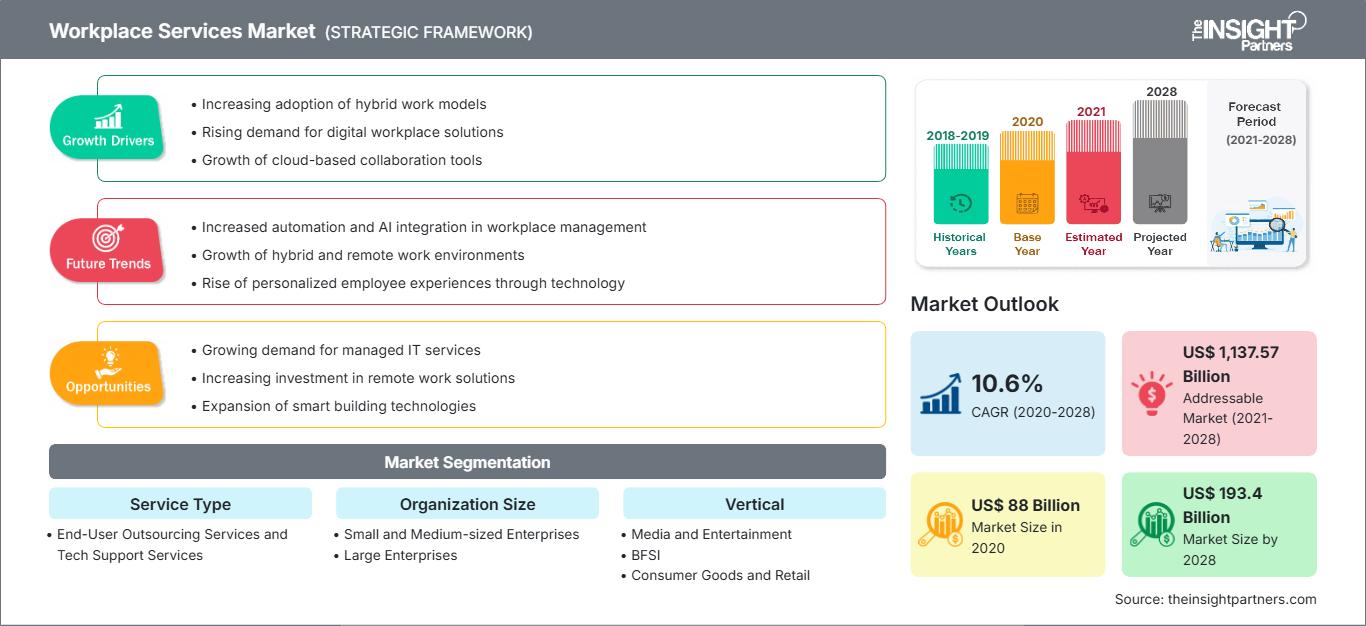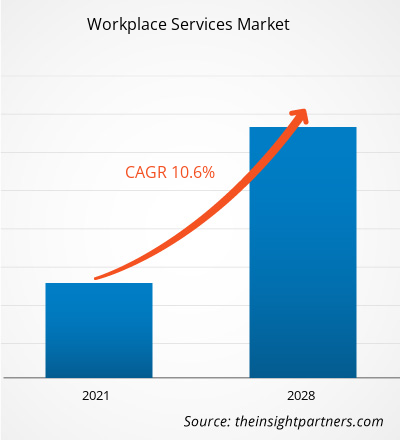El mercado de servicios en el lugar de trabajo se valoró en US$ 88.000 millones en 2020 y se proyecta que alcance los US$ 193.400 millones en 2028; se espera que crezca a una CAGR del 10,6% entre 2021 y 2028.
La tecnología ofrece numerosas ventajas para las empresas. El crecimiento exponencial de aplicaciones, dispositivos y redes está generando un impacto positivo en la cultura laboral. Entornos laborales más seguros, entornos de trabajo híbridos, mayor ciberseguridad y una fuerza laboral globalmente dispersa son algunos de los aspectos que contribuyen al concepto de lugar de trabajo moderno y, por lo tanto, influyen en el crecimiento de los servicios en el lugar de trabajo. Por lo tanto, las infraestructuras de TI consolidadas y las pequeñas, medianas y grandes empresas de todas las regiones demandan servicios en el lugar de trabajo. Se prevé que empresas de todos los tamaños inviertan en tecnologías innovadoras y de vanguardia para operar sus negocios con eficacia. Empresas de todo el mundo utilizan servicios en el lugar de trabajo para impulsar sus negocios y optimizar sus esfuerzos, garantizando así la menor inversión posible en diversos procesos.
Personalice este informe según sus necesidades
Obtendrá personalización en cualquier informe, sin cargo, incluidas partes de este informe o análisis a nivel de país, paquete de datos de Excel, así como también grandes ofertas y descuentos para empresas emergentes y universidades.
Mercado de servicios en el lugar de trabajo: perspectivas estratégicas

-
Obtenga las principales tendencias clave del mercado de este informe.Esta muestra GRATUITA incluirá análisis de datos, desde tendencias del mercado hasta estimaciones y pronósticos.
Impacto de la pandemia de COVID-19 en el mercado de servicios en el lugar de trabajo
La pandemia de COVID-19 ha sacudido a varias industrias. El enorme crecimiento en la propagación del virus ha obligado a los gobiernos de todo el mundo a imponer restricciones estrictas a la circulación de vehículos y personas. Debido a las prohibiciones de viaje, los confinamientos masivos y los cierres de empresas, la pandemia está afectando negativamente a las economías e innumerables industrias en varios países. Los proveedores del mercado de servicios para el lugar de trabajo continuaron sus operaciones de forma remota para ofrecer los mejores servicios a sus usuarios finales. Incluso durante la pandemia, varios actores del mercado se mantuvieron bien posicionados para apoyar a sus usuarios finales durante la crisis. La pandemia de COVID-19 ha impulsado a las empresas a impulsar sus transformaciones digitales, lo que ha resultado en la erradicación de las barreras tradicionales al progreso. Las empresas continúan ayudando a sus usuarios finales mediante la interacción virtual, la modernización y migración de aplicaciones a la nube, la habilitación de una fuerza laboral remota y el enfoque en la ciberseguridad y la resiliencia de TI.
Perspectivas del mercado de servicios en el lugar de trabajo
Creciente importancia de la movilidad empresarial
La movilidad empresarial es un término amplio que incluye la virtualización móvil, la gestión de dispositivos móviles y la virtualización móvil, que impulsan la productividad, optimizan los servicios y mejoran la experiencia del usuario. El sector de la movilidad empresarial ha experimentado un gran desarrollo, ya que las empresas buscan servicios que puedan gestionar todas las funciones de seguridad móvil, desde dispositivos y software hasta la protección de datos. Actualmente, la demanda de movilidad empresarial entre los trabajadores está en su punto máximo, especialmente debido al brote de COVID-19, que está impulsando el teletrabajo. La creciente adopción de la movilidad empresarial permite a las empresas controlar, actualizar e incluso borrar datos de los dispositivos a distancia. La movilidad empresarial permite a los empleados acceder de forma segura a datos empresariales confidenciales sin necesidad de implementar aplicaciones o software en sus dispositivos. Por lo tanto, todas estas ventajas están impulsando la demanda de servicios para el lugar de trabajo en todos los sectores verticales del mundo.
Perspectivas del mercado basadas en el tipo de servicio
Según el tipo de servicio, el segmento de servicios de externalización para usuarios finales dominó el mercado. Estos servicios incluyen servicios de gestión de red, soporte remoto, generación de informes y documentación estándar y ad hoc, servicios de escritorios virtuales alojados, servicios de software, movilidad y seguridad.
Perspectivas del mercado basadas en el tamaño de la organización
En cuanto al tamaño de la organización, el segmento de las grandes empresas dominó el mercado. Las grandes empresas de todo el mundo se centran en la optimización de costes, así como en el aumento de la productividad general. La creciente necesidad de una plataforma integrada para la enorme cantidad de datos de diversos sectores y para la toma de decisiones críticas en aspectos como la estrategia, el marketing y la gestión de equipos, está impulsando la demanda de servicios para el lugar de trabajo entre las grandes empresas.
Perspectivas basadas en verticales
Por sector, el segmento de telecomunicaciones, TI e ITES mantiene una cuota de mercado significativa. Las industrias en expansión de telecomunicaciones, TI e ITES exigen servicios de trabajo altamente eficientes que permitan adoptar un enfoque integral en los procesos de flujo de trabajo mediante movilidad, colaboración y soporte al usuario, a la vez que se reducen los costos operativos de TI. Estos servicios satisfacen las necesidades actuales de entornos de trabajo digitalmente optimizados en este sector.
Los actores del mercado de servicios laborales se centran en estrategias como asociaciones, fusiones, adquisiciones e iniciativas de mercado para mantener su posición en el mercado. A continuación, se enumeran algunos avances de los actores clave:
En febrero de 2021, Unisys Corporation anunció su alianza con Lenovo. En virtud de esta alianza, Unisys Corporation respaldaría las soluciones de Internet de las Cosas (IoT) de Lenovo con sus Servicios de Lugar de Trabajo Digital.
En junio de 2020, Wipro anunció su alianza con Citrix y Microsoft. Gracias a esta alianza, Wipro aprovecharía los servicios de alojamiento ofrecidos por Citrix y Microsoft para la implementación rápida y segura de espacios de trabajo digitales confiables (incluidas suites de aplicaciones).
En diciembre de 2020, DXC Technology anunció su alianza con Microsoft. En virtud de esta alianza, DXC Technology aprovecharía la suite de servicios de Microsoft, como Dynamics 365 y Power Platform, y Microsoft 365 y Teams, para optimizar los Servicios y la solución Modern Workplace de DXC Technology.
Perspectivas regionales del mercado de servicios en el lugar de trabajo
Los analistas de The Insight Partners han explicado detalladamente las tendencias y los factores regionales que influyen en el mercado de servicios laborales durante el período de pronóstico. Esta sección también analiza los segmentos y la geografía del mercado de servicios laborales en América del Norte, Europa, Asia Pacífico, Oriente Medio y África, y América del Sur y Central.
Alcance del informe de mercado de servicios en el lugar de trabajo
| Atributo del informe | Detalles |
|---|---|
| Tamaño del mercado en 2020 | 88 mil millones de dólares estadounidenses |
| Tamaño del mercado en 2028 | US$ 193.4 mil millones |
| CAGR global (2020-2028) | 10,6% |
| Datos históricos | 2018-2019 |
| Período de pronóstico | 2021-2028 |
| Segmentos cubiertos |
Por tipo de servicio
|
| Regiones y países cubiertos |
América del norte
|
| Líderes del mercado y perfiles de empresas clave |
|
Densidad de actores del mercado de servicios en el lugar de trabajo: comprensión de su impacto en la dinámica empresarial
El mercado de servicios para el lugar de trabajo está creciendo rápidamente, impulsado por la creciente demanda de los usuarios finales debido a factores como la evolución de las preferencias de los consumidores, los avances tecnológicos y una mayor conciencia de los beneficios del producto. A medida que aumenta la demanda, las empresas amplían su oferta, innovan para satisfacer las necesidades de los consumidores y aprovechan las tendencias emergentes, lo que impulsa aún más el crecimiento del mercado.

- Obtenga una descripción general de los principales actores clave del mercado de servicios en el lugar de trabajo
Por tipo de servicio
- Servicios de subcontratación para usuarios finales
- Servicios de soporte técnico
Por tamaño de la organización
- PYMES
- Grandes empresas
Por Vertical
- Telecomunicaciones – TI e ITES
- BFSI
- Fabricación
- Bienes de consumo y venta minorista
- Salud y ciencias de la vida
- Gobierno y sector público
- Energía y servicios públicos
- Medios y entretenimiento
- Educación
- Otros
Por geografía
-
América del norte
- A NOSOTROS
- Canadá
- México
-
Europa
- Francia
- Alemania
- Italia
- Reino Unido
- Rusia
- Resto de Europa
-
Asia Pacífico (APAC)
- Porcelana
- India
- Corea del Sur
- Japón
- Australia
- Resto de APAC
-
Oriente Medio y África (MEA)
- Sudáfrica
- Arabia Saudita
- Emiratos Árabes Unidos
- Resto de MEA
-
América del Sur (SAM)
- Brasil
- Argentina
- Resto de SAM
Perfiles de empresas
- Tecnología DXC
- Wipro
- Corporación IBM
- Tecnologías HCL
- TCS
- Datos de NTT
- CompuCom Systems Inc.
- ATOS
- UNISYS
- Fujitsu Ltd.
- Competente
- Accenture PLC
- Análisis histórico (2 años), año base, pronóstico (7 años) con CAGR
- Análisis PEST y FODA
- Tamaño del mercado, valor/volumen: global, regional y nacional
- Industria y panorama competitivo
- Conjunto de datos de Excel
Informes recientes
Testimonios
Razón para comprar
- Toma de decisiones informada
- Comprensión de la dinámica del mercado
- Análisis competitivo
- Información sobre clientes
- Pronósticos del mercado
- Mitigación de riesgos
- Planificación estratégica
- Justificación de la inversión
- Identificación de mercados emergentes
- Mejora de las estrategias de marketing
- Impulso de la eficiencia operativa
- Alineación con las tendencias regulatorias






















 Obtenga una muestra gratuita para - Mercado de servicios en el lugar de trabajo
Obtenga una muestra gratuita para - Mercado de servicios en el lugar de trabajo